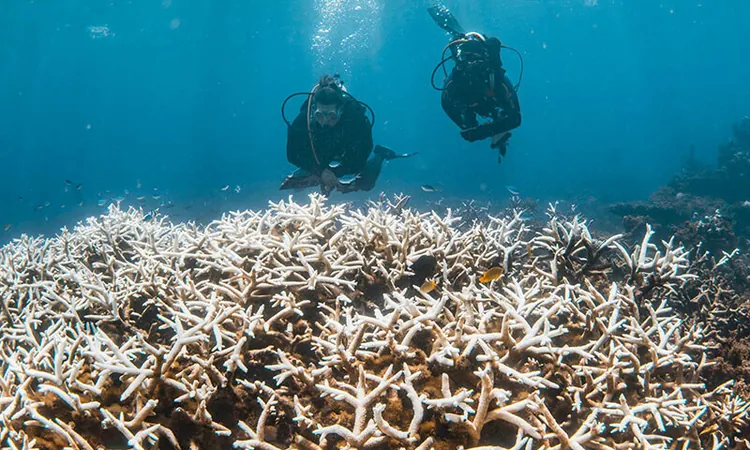
Devastating Coral Bleaching Crisis Hits Ningaloo Reef: The Unfolding Disaster
2025-03-26
Author: Ling
In a shocking revelation, scientists announced on Wednesday that Australia’s Ningaloo Reef is currently experiencing an "unprecedented" mass bleaching event, resulting in large areas of this iconic ecosystem turning a ghostly white.
The stunning 300-kilometre Ningaloo Reef, a part of a World Heritage-listed marine park famed for its vibrant coral and diverse marine life, has been severely impacted by a prolonged marine heatwave. Ocean scientist Kate Quigley described the situation as a dire consequence of elevated ocean temperatures, telling AFP, “The warm oceans have just cooked the corals this year.”
Despite ongoing assessments by environmental authorities, early data suggests that the current situation could be the most severe bleaching event for the reef since 2011. Quigley emphasized the extent of the crisis, stating, “It’s gone deep. It’s not just the top of the reef that is bleaching; we are seeing many different species of coral affected.”
The National Oceanic and Atmospheric Administration reported that ocean temperatures off Western Australia have soared up to three degrees Celsius above average over recent months, breaching the critical "bleaching threshold." This phenomenon occurs when elevated temperatures force corals to expel the colorful algae that live in their tissues, leading to a loss of color and vitality. While bleaching signifies stress in coral communities, Quigley pointed out that it does not immediately mean death for the corals—although prolonged exposure to such conditions can lead to severe mortality rates.
In addition to the Ningaloo Reef, smaller areas of coral bleaching have also been identified at the northern reaches of the more famous Great Barrier Reef on Australia’s east coast. This simultaneous event at both marine parks is unusual, as they typically respond to different climate patterns. Quigley explained, “What we’re seeing is that the level of ocean warming is so extreme that it’s overriding local conditions in various regions.”
This alarming trend is mirrored by a broader global phenomenon. In 2024, average global temperatures reached unprecedented highs, causing alarm among climate scientists about the health of the world’s oceans. A recent report from a leading US science agency highlighted that nearly 80% of global coral reefs have been impacted by heat-related bleaching within the past two years.
As climate change continues to intensify, coral ecosystems worldwide face increasing threats not only from warmer seas but also from overfishing and pollution. An Australian National University study released last week indicated that sea surface temperatures around Australia were the highest ever recorded for 2024.
With Australia sitting atop rich deposits of fossil fuels, the balance between economic growth and environmental sustainability grows ever more precarious. The country is grappling with an uptick in extreme heatwaves, bushfires, and drought conditions—events closely linked to the ongoing climate crisis.
The implications of the wave of coral bleaching could be catastrophic, not only for marine biodiversity but also for industries reliant on healthy reefs, including tourism and fishing. Scientists, environmentalists, and policymakers are now calling for urgent action to mitigate the effects of climate change and safeguard these vital ecosystems before it’s too late.



 Brasil (PT)
Brasil (PT)
 Canada (EN)
Canada (EN)
 Chile (ES)
Chile (ES)
 Česko (CS)
Česko (CS)
 대한민국 (KO)
대한민국 (KO)
 España (ES)
España (ES)
 France (FR)
France (FR)
 Hong Kong (EN)
Hong Kong (EN)
 Italia (IT)
Italia (IT)
 日本 (JA)
日本 (JA)
 Magyarország (HU)
Magyarország (HU)
 Norge (NO)
Norge (NO)
 Polska (PL)
Polska (PL)
 Schweiz (DE)
Schweiz (DE)
 Singapore (EN)
Singapore (EN)
 Sverige (SV)
Sverige (SV)
 Suomi (FI)
Suomi (FI)
 Türkiye (TR)
Türkiye (TR)
 الإمارات العربية المتحدة (AR)
الإمارات العربية المتحدة (AR)